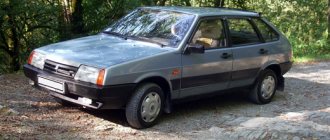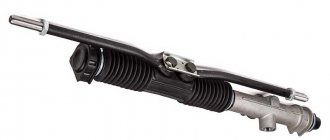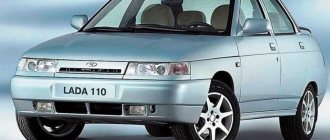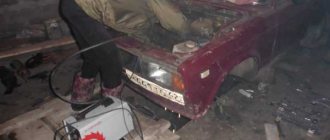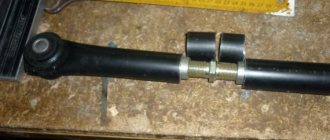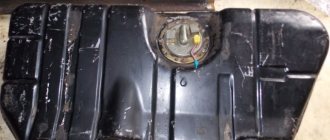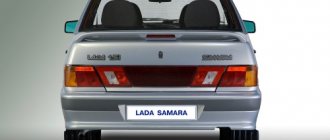The very first VAZ car was the VAZ-2101 Zhiguli model, which was released in the spring of 1970. Production was based on an analogue of the Fiat concern, and VAZ owes its appearance to the FIat-124 car, which appeared 4 years earlier.
The difference lies only in some design modifications.
The weight of the first VAZ car was 955 kg, of which only 114 were the engine itself. Now the Russian auto industry is more diverse in car models, and VAZ is not as popular as before, especially when compared with imported manufacturers.
Technical characteristics of VAZ 2115
Performance characteristics of the VAZ 2115 fifteenth sedan
Maximum speed: 170 km/h Acceleration time to 100 km/h: 14 sec Fuel consumption per 100 km in the city: 10 l Fuel consumption per 100 km on the highway: 5.7 l Fuel consumption per 100 km in the combined cycle: 7.3 l Fuel tank volume: 43 l Vehicle curb weight: 970 kg Permissible gross weight: 1395 kg Tire size: 175/70 R13
Engine characteristics
Location: front, transverse Engine capacity: 1500 cm3 Engine power: 78 hp Number of revolutions: 5400 Torque: 115/3000 N*m Power system: Distributed injection Turbocharging: no Gas distribution mechanism: OHC Cylinder arrangement: In-line Number of cylinders: 4 Cylinder diameter: 82 mm Piston stroke: 71 mm Compression ratio: 9.9 Number of valves per cylinder: 2 Recommended fuel: AI-95
Brake system
Front brakes: Disc Rear brakes: Drum ABS: yes
Steering
Power steering: no Steering type: Rack and pinion
Transmission
Drive: Front Number of gears: manual gearbox - 5 Gear ratio of the main pair: 3.9
Suspension
Front suspension: Shock absorber Rear suspension: Coil spring
Body
Body type: sedan Number of doors: 4 Number of seats: 5 Vehicle length: 4330 mm Vehicle width: 1620 mm Vehicle height: 1415 mm Wheelbase: 2460 mm Front track: 1400 mm Rear track: 1370 mm Ground clearance (clearance): 160 mm Trunk volume: 427 l
Production
Year of manufacture: from 1997 to 2012
What is the weight of the VAZ-2115
The very first VAZ car was the VAZ-2101 Zhiguli model, which was released in the spring of 1970.
Production was based on an analogue of the Fiat concern, and VAZ owes its appearance to the FIat-124 car, which appeared 4 years earlier. The difference lies only in some design modifications.
The weight of the first VAZ car was 955 kg, of which only 114 were the engine itself. Now the Russian auto industry is more diverse in car models, and VAZ is not as popular as before, especially when compared with imported manufacturers.
About VAZ-2115
The VAZ-2115, part of the Lada Samara line, is radically different from its predecessor both in appearance and, accordingly, in dimensions. The front-wheel drive subcompact sedan developed by VAZ is no longer produced. Its production began in 1997 and closed not so long ago - in 2012, which is quite reasonable, given the speed of modernization of vehicles.
This model became the first-born of its line and was designed under the code name “Samara-2”. The basis of the modernization is to change the rear part of the body - lighting devices and the luggage compartment lid.
The entire model is a restyling of the VAZ-21099.
If you look closely, there are quite a lot of differences:
- more rounded sections of the body;
- trunk lid shape;
- rear and front optics;
- bumpers painted to match the body color;
- door moldings;
- threshold fairings;
- spoiler with additional brake light;
- completely new interior;
- improved electrical equipment.
All models with pilot modifications were equipped with VAZ-21083 carburetor engines, but this only happened from 1997 to 2000. In 2008, the VAZ-2115 underwent significant cosmetic changes in order to be a little more suitable according to modern criteria to foreign car brands. But this did not become a winning idea - the car was discontinued.
Technical characteristics and parameters of the car
The overall dimensions of the VAZ-2115 car are not much different from other car models of a similar modification.
- the total weight of the VAZ-2115 is exactly 1 ton - 1,000 kg;
- the vehicle's carrying capacity is slightly less than half its weight - 425 kg;
- fuel tank volume – 43 l;
- number of seats – 5 pcs.;
- luggage compartment volume – 427 l;
- assembly – Russia, Tolyatti;
- length – 4.33 m;
- width – 1.65 m;
- height – 1.4 m;
- ground clearance - 16.5 cm;
- wheelbase - 2.46 m;
- rear track - 1.37 m;
- front track - 1.4 m.
Engine characteristics depend on the year of manufacture of the car - 2111, 21114, 111083 (but all four-cylinder with an approximate weight of up to 130 kg).
Initially, all models were equipped with 1.5 liter carburetor engines. But now tuning enthusiasts are modernizing their iron horses. At first there were 8-valve 1.6-liter engines, and later 16-valve engines.
Even years after the VAZ-2115 was discontinued, many tuning kits can still be found in specialized stores, which indicates the popularity of this sedan.
The VAZ-2115, or “tag” in common parlance, was discontinued at the end of 2012 due to the launch of the next, safer VAZ model, which was distinguished by increased safety and a modern appearance - the Lada Granta.
How to maintain the engine
There are several requirements that must be met to ensure that the motor serves you for a long time:
- every time after a run of 15,000 kilometers you need to change the engine oil (use semi-synthetic or mineral, the engine is absolutely not demanding on this);
- The timing belt should be replaced after 50 thousand kilometers;
- After 10 thousand kilometers, manual adjustment of the valves is necessary.
The last requirement for service makes life most difficult for car enthusiasts who own a VAZ-2115. The fact is that this procedure is very complicated and a limited number of people can adjust the valves, so you will have to contact a specialized service center.
What are the body dimensions of the VAZ-2115
Car VAZ-2115
VAZ-2115 / Lada Samara is a four-door front-wheel drive sedan developed by the Volzhsky Automobile Plant).
The updated VAZ-2115 sedan was created as part of the Samara-2 project, work on which began in the early 90s. Moreover, thinking first of all about the new appearance of front-wheel drive cars, in Tolyatti they did not forget about aerodynamics. Therefore, in 1993, the VAZ design team came to the Dmitrov Automotive Test Site - the VAZ team decided to work on the style of the updated cars right in the wind tunnel!
We started by removing standard bumpers from ordinary VAZ-21093 and VAZ-21099 cars, and in their place they fitted new ones, which were fashioned from plasticine. The designers noticeably rounded the corners of the plasticine bumpers, and along the lower edge of the side doors they placed developed sill moldings that “flow” onto the edges of the wings. Using the same technology, a new, slightly longer and sharper “muzzle” was made. The appearance was complemented by a small wing on the trunk lid.
After several “purge” sessions in the wind tunnel, during which the shape of all parts was optimized, the designers came to the final version of the plasticine “armor”. And we went back to Togliatti. And a few months later, “live” Samara-2, embodied in metal and plastic, was driven to Dmitrov! These were the VAZ-2113 and VAZ-2114 hatchbacks - an alternative to the “eights” and “nines” - and the VAZ-2115 sedan, which was supposed to replace the “ninety-ninth” model. The Togliatti residents were generally satisfied with the results of the car purging and were already planning to prepare Samara-2 for mass production. The year was 1994.
Then the crisis came. The main forces and funds at the plant were devoted to finishing work on the “ten”, and funding for the Samara-2 project was severely cut. And as a result, of the three cars, they decided to bring only the VAZ-2115 to mass production. Almost two years were spent on this. Only in 1996, the “fifteenth” began to be produced in small batches at the VAZ pilot production facility. Since 2001, assembly began on the factory assembly line.
In comparison with its predecessor (VAZ-21099), the VAZ 2115 has lengthened by 225 mm. The appearance of the car has noticeably changed - the front and rear parts have been changed, the interior has been updated, while the sides, doors and roof remain the same. The new model is distinguished by the front part of the body with original headlights, a modified shape of the hood and front fenders, new taillights with an insert between them, bumpers painted in body color, a trunk spoiler with an additional brake light, door moldings, door sill fairings, a new trunk lid with floor level connector. New efficient lighting technology is provided.
A number of design solutions were borrowed from the “tenth” family of VAZs - an adjustable steering column, upper mounting points for front seat belts, and an instrument cluster. The rear number of the car, like on the “ten”, is located on the bumper.
The car is equipped with 1.5 and 1.6 liter petrol engines. Initially, modifications with a carburetor engine were produced. But in 2001, a modification was released with an engine with distributed fuel injection. To increase service life and reduce noise at idle, a new clutch driven disc with an idle damper is provided.
The display unit of the on-board control system carries information about closing the door locks, unfastened seat belts, extreme wear of the brake pads, the ignition key left, the level of oil, coolant and washer fluids. The new heater design used ensures efficient heating of the interior.
The VAZ-2115 is available in the following configurations: “standard” (VAZ-21150-20), “norm” (VAZ-21150-21) and “luxury” (VAZ-21150-22).
Modernization
Whatever one may say, after several years of operation, even the most elegant car wants to be modernized. Automakers have long understood this, periodically introducing restylings and tuners making changes on their own.
Regarding the 15th model, many attempts at modernization were carried out at the amateur level. Some images of such tuned cars have every right to be called masterpieces, others, to put it mildly, are not impressive.
When the car's mileage reaches 50 thousand km, it's time to think about the suspension. Tuners recommend upgrading it first, as one of the weakest areas.
Over time, the reaction is no longer the same as before, when even on the icy road 2115 confidently passed through flat sections and turns. Now the rear of the car begins to toss from side to side, and the acceleration dynamics and handling are no longer the same.
The second, no less important note relates to the comfort of the car. Over time, the already frail sound insulation completely wears out. Everything starts to creak, including the rear parcel shelf.
Modernization also concerns the introduction of various options. To be honest, almost all VAZ car models reach the end user as “semi-finished products”. There is no competent anti-corrosion treatment of the body, there are no required comfort and safety parameters.
Here are the activities that are usually carried out, such as tuning and modernization on the 15th model:
- Installation of lockers and protection of the power unit crankcase;
- Replacement of sedan door and trunk locks with new, silent ones;
- Replacement of covers;
- Modernization of disks by installing new cast ones;
- Noise insulation and anti-creak treatment of various parts of the body, necessarily the roof and doors;
- Body painting and anti-corrosion treatment of the floor and other components most susceptible to corrosion;
- Installation of body reinforcement (struts);
- Replacing bumpers;
- Replacement of wing and spoilers;
- Remodeling doors and much more.
Painting
Painting has a longer history than the car itself. At least if you mean a paint gun. Modern tools are made at the highest level and make it easy and quick to paint a part or the entire body in the appropriate color.
Note that small scratches on the paintwork of the 15th model can be easier to remove by polishing. But if they are too deep and reach the ground or metal, you have to paint them.
As you know, painting can be carried out in 2 ways: partially, when the parts are painted with a transition, or completely.
Transition painting is applicable only in cases where one or another body section is being restored. This method has both advantages and disadvantages.
Note. In particular, with this method, body parts will not need to be dismantled, and therefore the structure will not be damaged. On the other hand, partial painting cannot guarantee the long-lasting effect of paintwork as much as complete painting.
It was written above about the pistol, but you can paint the 15th model in your garage using a spray can. But this method has many disadvantages:
- The spray can has an uneven spray, which significantly complicates painting (an overly saturated jet causes smudges);
- It is difficult to choose the appropriate color of paint sold in cans;
- Spray paint fades faster over time (such paint protects the surface less well).
Advice. If, however, you chose the spray can painting method, it is recommended to apply thin layers, keeping the spray can as far as possible from the body part.
Example of painting a rusty part
Let's say that this is the wing of the 15th VAZ model:
- Wash the car completely;
- Get rid of rust by sanding the part with coarse sandpaper and applying a degreaser;
- Restore the geometric dimensions of the part by applying layers of putty.
Attention. If the body part is subject to frequent vibrations, then ordinary putty will not work. You need to choose one with aluminum particles.
Regarding the application of putty:
- It must first be properly diluted with the hardener, doing this in small portions (the mixture dries quickly);
- You need to apply it directly to the surface, remembering that the putty dries for about a quarter of an hour if the room temperature is at least 20 degrees.
Read also: Engine oil for Duster 4x4
We continue the painting stage:
- After the putty has dried, you need to start cleaning (treating the surface with sandpaper until the part becomes smooth);
- We apply the first layer of primer, which will protect the part from corrosion and guarantee the durability of the paintwork.
Note. When choosing a primer, you need to pay attention to its consistency with the color of the car’s paint. So, if the car is painted black, the primer should be of some dark shade; if it is silver, it is advisable to select a light shade.
More on primer:
- It is advisable that it be applied using special equipment and tools (spray gun, compressor, respirator, etc.);
- Before applying primer, it is recommended to cover the car with a special film or, in extreme cases, paper;
- It is advisable to apply the primer in two layers, first degreasing the surfaces.
- After the soil has dried, it must be treated with 800-grit sandpaper;
- We now prepare the room for painting, removing all the dust around with water (we cover all parts of the car except the wing);
- We apply the paint in several layers, leaving each layer to dry for 1 minute (as a rule, after the 3rd layer the wing will already be what it needs);
- We wait for 15 minutes to dry completely, and then coat it with varnish.
Advice. Before applying the varnish, it is recommended to go over the paint with a clean cloth, since the varnish itself is very sensitive to remaining grains of sand (even if they are microscopic).
The varnish is also applied in two layers, allowing it to dry for 2 minutes.
Body reinforcement
This modernization helps to significantly simplify the operation of the machine. After such strengthening, cornering on VAZ models will be more confident, even at high speed. In addition, and more importantly, the degree of deformation is reduced.
It is recommended to install spacers from well-known manufacturing companies, but it is better to avoid products made in a handicraft manner.
Installation will not create any difficulties. It will be enough to buy the part, and then install and secure it accordingly.
Modifications of VAZ-2115
Initially, modifications were produced with a carburetor engine with a displacement of 1.5 liters. In the model range of AVTOVAZ JSC 2001-2002. modifications of the VAZ-2115 model with 1.1 liter engines are presented. (VAZ-2115 (1.1); volume 1.3 l. (VAZ-2115 (1.3) and engine, volume 1.5 l. with distributed fuel injection (VAZ-2115i)
Malfunctions
| FAULTS | CAUSES AND REMEDIES |
| The engine does not start or runs with detonation and strong vibrations. | Injection system failure. It is necessary to open the engine, clean the injectors and check their functionality. |
| The engine is shaking, the idle speed is floating. | The throttle sensor or idle speed control has failed. Repairs are made only after a thorough diagnosis and consist of replacing the failed element. |
| The engine takes a long time to warm up or does not reach operating temperature at all. | The thermostat failed, which closed the circulation of liquid along a large circuit. The repair consists of replacing the thermostat. |
| The appearance of an extraneous knocking sound in the engine under load. | Valves are knocking and require adjustment. Repair in this case involves opening the engine and adjusting the valve clearance. |
How much does a VAZ car sold for scrap weigh?
The most common vehicles in the post-Soviet space have always been considered to be the products of the Volga automobile industry. These cars faithfully served their owners for decades. Therefore, the question of how much a VAZ 2107 weighs for scrap metal does not surprise anyone. The same applies to other car models that are subject to recycling.
The Lada Seven, according to documents, has a mass of 1049 kg. However, its weight is practically no different from any other brand of car from the Volzhsky Automobile Plant. The average weight of this Soviet car, which is often scrapped, is around one ton.
Sometimes owners of relatively new cars have to go to a metal collection point. The vehicle may be damaged as a result of an accident or other accident. In some situations, from an economic point of view, the only right decision would be to scrap the car.
Sometimes drivers prefer to disassemble the car themselves. Therefore, the relevance of the question of how much a VAZ 2101 body weighs for scrap metal is understandable. Considering that Kopeyka is the oldest representative of this line of the domestic automobile industry, it is the leader among cars that can be recycled. Its scrap weight is 955 kg, of which the body takes up about 280.
Features of car recycling
Before you scrap your car, you should familiarize yourself with the principles of this procedure. The average weight of a vehicle is 1000 kg. If the entire car can be recycled, the collection point will deduct 30% for clogging. The latter includes all non-metallic elements, pollution, etc.
Let's consider how much a car for scrap metal weighs using the example of a VAZ 2105. The weight of the latter is 955 kg. Thus, taking away the blockage, we get about 660 kg. You should also take into account the price of scrap, which differs depending on the city. As a rule, in megacities, the number of rubles received for a car will significantly exceed the amount earned in a similar organization in a small locality.
Before calculating the profit from a scrapped car, you need to take into account transportation costs. If the car is a pile of metal, you need to take care of a tow truck. If there are spinning wheels and functional steering, the car can be transported in tow. Then, this expense item will not be so significant. Therefore, in order to calculate how much a Zhiguli costs when scrapped, it is not enough to know how much a VAZ 2109 or 21099 weighs for scrap metal (915 kg). It is necessary to take into account the features of recycling and the requirements of collection points. It would be useful to know the average cost of scrap metal in the region. Additional awareness will allow you to avoid fraud on the part of unscrupulous receivers.
Despite the fact that disassembling a car is a labor-intensive procedure, many owners still decide to take this step. Thus, you can sort ferrous and non-ferrous metals and hand them over separately, removing the good parts. From an economic point of view, the procedure will be justified.
Let's consider how much a VAZ 2106 weighs for scrap metal based on individual significant structural elements:
- body – about 300 kg;
- bridge – 52 kg;
- motor – 140 kg.
It should be noted that dismantling machine parts requires a lot of time and certain skills. In the absence of the latter, it would be more rational to recycle it entirely.
VAZ 2115
The domestic sedan VAZ 2115 is known to almost everyone; its production was launched in 1997, that is, it appeared earlier than the VAZ 2114, and came to replace the VAZ 21099 in the company’s line.
The production of this car lasted until 2012 and after that they created a now popular replacement, the Lada Granta. Over the entire period of production, the model gained considerable popularity in our country, and once it was subjected to restyling, the essence of which was to replace the moldings.
There is no point in discussing her appearance, since you have all seen her and know what she looks like. Dimensions:
- length – 4330 mm;
- width – 1650 mm;
- height – 1402 mm;
- wheelbase – 2460 mm;
- ground clearance - 170 mm.
Specifications
| Power | Torque | Overclocking | Maximum speed | Number of cylinders | ||
| Petrol | 1.5 l | 68 hp | 103 H*m | 13 sec. | 155 km/h | 4 |
| Petrol | 1.5 l | 78 hp | 115 H*m | 13.2 sec. | 158 km/h | 4 |
| Petrol | 1.6 l | 81 hp | 120 H*m | 13.2 sec. | 160 km/h | 4 |
More details
The model had weak units with a volume of 1.5 and 1.6 liters in its line; you can see their characteristics above. They were paired only with a 5-speed manual transmission. Nevertheless, for some time there was a package that equipped the model with a 1.3-liter rotary carburetor unit producing 135 horsepower, allowing the model to reach a hundred in 9 seconds.
The 1.5-liter unit produces 68 horsepower, not much, but enough to accelerate the model to hundreds in 13 seconds. The maximum speed will be 158 km/h. Consumption is around 9 liters in the city and it is advisable to fill in 95 gasoline.
There is also an 8-valve engine with a volume of 1.5 liters, but producing 78 horses. Despite the increased power, the dynamics became worse, but the maximum speed increased to 165 km/h.
The latest engine is also an 8-valve engine, but its volume has been increased to 1.6 liters. Exactly the same dynamics as the previous units, the maximum speed is generally 160 km/h. At the same time, it consumes as much as 10 liters of gasoline in the city.
Interior
The interior decoration is simple, with regular chairs with fabric upholstery. In the back there is a sofa for three passengers. There is not much space, but in principle it is enough. There is a simple stove, which is very easy to operate, since everyone is familiar with this unit.
The steering column is familiar to many - a simple 3-spoke steering wheel. The instrument panel is also made in the classic style for AvtoVAZ, these are ordinary analog gauges and a small and uninformative on-board computer.
The trunk of the car, of course, is not particularly large, but for ordinary purposes it is enough. The luggage compartment volume is 445 liters.
In principle, the VAZ 2115 is an acceptable car for its price; of course, it has disadvantages and problems, but the price tells you about it.
Main author of the site and founder of several automotive Internet projects
Tuning
There are several possible ways to increase engine power. Let's talk about these tuning options in more detail:
- Chip tuning of the VAZ 2115 engine will not allow you to obtain any noticeable effect. Even by replacing the engine control unit, the car owner will be able to get 3-5 horsepower, the increase of which will be almost imperceptible.
- Deep engineering tuning of VAZ 2115 engines, which involves replacing the camshaft and other power elements, will increase the engine power to 85 horsepower. Such an increase of 10 horses will already be noticeable, and the car will accelerate faster, especially from low revs.
- Replacing the throttle body and exhaust will increase power to 95 horsepower.
- If the engine power limit of 100 horses is important to you, then you need to install lightweight valves, mill the cylinder head and replace the intake manifold. A car with such a tuned engine will accelerate 1-2 seconds faster than with a basic 78-horsepower engine. A further increase in power by replacing internal power parts will not allow you to obtain the desired horsepower, and the service life of the motor is significantly reduced.
- An alternative way to increase the power of a VAZ 2115 engine is to install a compressor with a pressure of about 0.5 bar. If the compressor is properly configured, the engine power will be about 120 horsepower. At the same time, when resorting to such tuning, the car owner must be prepared to reduce the service life of the engine, which may require appropriate major repairs after only 75-100 thousand kilometers.
How much does the body of a VAZ 2115 weigh without everything?
| Model | Curb weight, kg | Permitted maximum weight, kg |
| VAZ-2101 | 955 | 1355 |
| VAZ-2102 | 1010 | 1440 |
| VAZ-2103 | 955 | 1355 |
| VAZ-2104 | 1020 | 1475 |
| VAZ-2105 | 995 | 1395 |
| VAZ-2106 | 1045 | 1445 |
| VAZ-2107 | 1030 | 1430 |
| VAZ-2108 | 900 | 1325 |
| VAZ-2109 | 945 | 1370 |
| VAZ-21099 | 970 | 1395 |
| VAZ-21011 | 955 | 1355 |
| VAZ-2110 | 1010 | 1485 |
| VAZ-21102 | 1020 | 1495 |
| VAZ-21103 | 1040 | 1515 |
| VAZ-2111 | 1040 | 1540 |
| VAZ-21111 | 1030 | 1530 |
| VAZ-21113 | 1060 | 1560 |
| VAZ-2112 | 1040 | 1515 |
| VAZ-21122 | 1020 | 1495 |
| VAZ-2113 | 975 | 1400 |
| VAZ-2114 | 970 | 1395 |
| VAZ-2115 | 985 | 1410 |
| VAZ-2121 | 1210 | 1610 |
| VAZ-2170 Lada Priora | 1088 | 1578 |
| VAZ-2170 Lada Priora station wagon | 1088 | 1593 |
| VAZ-1118 Lada Kalina | 1070 | 1545 |
The curb weight of a vehicle is the weight of a vehicle with standard equipment, various consumables (oil, coolant, etc.), but minus the weight of passengers, driver and luggage.
Dry weight is equal to curb weight, but only without fuel, some equipment and consumables. That is, this is the mass of an unloaded vehicle without fuel.
The permissible gross weight is the weight of the maximum loaded vehicle provided by the manufacturer. This is sometimes called the maximum permissible mass. It is better not to go beyond the limits of this indicator, unless, of course, you want your car to last for a very long time. The increased load has a negative impact on the car body and suspension parts.
Random entries - how much does it weigh:
I took the car for spare parts, I took off everything I could, I wanted to sell it as metal, but there are no scales to weigh the body. If anyone knows, tell me how much the bare body of a VAZ 2110 weighs (without doors, trunk lid, hood, rear and front beams, A-pillars, and fenders) in advance thanks a lot!
Weight of passenger cars in tabular format
We present to your attention a table that shows the weight of the car by brand.
| car model | Curb weight |
| Weight of the Oka 1111 car, weight of the Okushka | 635 kg |
| Weight of the car Oka 1113 | 645 kg |
| Weight of a VAZ 2101 car, weight of a penny | 955 kg |
| Weight of the VAZ 2102 car | 1010 kg |
| Weight of the VAZ 2103 car | 965 kg |
| Weight of the car VAZ 2104, weight of tens 2110 | 1020 kg |
| The weight of the VAZ 2105 car, the weight of the five | 1060 kg |
| Weight of the VAZ 2106 car, weight of the six | 1045 kg |
| Weight of the VAZ 2107 car, weight of the seven | 1049 kg |
| Weight of the VAZ 2108 car | 945 kg |
| Weight of the VAZ 2109 car, weight of the nine | 915 kg |
| Weight of the VAZ 2111 car | 1055 kg |
| Weight of a VAZ 2112 car, weight of a twelve-wheeler | 1040 kg |
| Weight of the VAZ 2113 car | 975 kg |
| Weight of the VAZ 2114 car, weight of the four | 985 kg |
| Weight of the VAZ 2115 car, weight of the tag | 1000 kg |
| Weight of the VAZ 2116 car | 1276 kg |
| Weight of the VAZ 2117 car | 1080 kg |
| Weight of the Niva 2121 car | 1150 kg |
| How much does a Chevrolet Cruze weigh (Chevrolet Cruze weight) | 1285-1315 kg |
| How much does a Chevrolet Niva weigh (Chevrolet Niva weight) | 1410 kg |
| How much does a GAZ (Volga) weigh, the weight of a Volga is 24 | 1420 kg |
| How much does GAZ 2402, GAZ 2403, GAZ 2404 weigh? | 1550 kg |
| How much does GAZ 2407 weigh? | 1560 kg |
| Car weight Moskvich 314 | 1045 kg |
| Weight Moskvich 2140 | 1080 kg |
| Weight Moskvich 2141 | 1055 kg |
| Car weight Moskvich 2335, 407, 408 | 990 kg |
| How much does a UAZ 3962, UAZ 452 weigh, how much does a UAZ loaf weigh? | 1825 kg |
| How much does UAZ 469 weigh? | 1650 kg |
| How much does UAZ Patriot weigh? | 2070 kg |
| How much does UAZ Hunter weigh? | 1815 kg |
| How much does Nissan weigh (weight of nissan x-trail car) | 1410-1690 kg |
| How much does Qashqai weigh (weight of Nissan Qashqai car) | 1297-1568 kg |
| How much does a Nissan Juke weigh (Nissan Beetle weight) | 1162 kg |
| Ford Focus car weight (how much does a Ford Focus weigh) | 965-1007 kg |
| Weight of the Ford Focus 2 car (how much does the Ford Focus 2 weigh) | 1345 kg |
| Weight of the Ford Focus 3 car (how much does the Ford Focus 3 weigh) | 1461-1484 kg |
| Ford Kuga car weight (how much does a Ford Kuga weigh) | 1608-1655 kg |
| Weight of the Ford Escort (how much does the Ford Escort weigh) | 890-965 kg |
| Weight of the Renault Logan car (how much does the Renault Logan weigh) | 957-1165 kg |
| Renault Duster car weight (how much does a Renault Duster weigh) | 1340-1450 kg |
| Renault Sandero car weight (how much does a Renault Sandero weigh) | 941 kg |
| Weight of the Opel Mokka car (how much does the Opel Mokka weigh) | 1329-1484 kg |
| Weight of the Opel Astra car (how much does the Opel Astra weigh) | 950-1105 kg |
| Mazda 3 car weight (how much does mazda 3 weigh) | 1245-1306 kg |
| Weight of the Mazda CX-5 (how much does the Mazda CX-5 weigh) | 2035 kg |
| Mazda 6 car weight (how much does mazda 6 weigh) | 1245-1565 kg |
| Volkswagen car weight (how much does a Volkswagen Tuareg weigh) | 2165-2577 kg |
| Weight of a Volkswagen Polo car (how much does a Volkswagen Polo weigh) | 1173 kg |
| Weight of the Volkswagen Passat car (how much does the Volkswagen Passat weigh) | 1260-1747 kg |
| How much does a Toyota Camry weigh (weight of a Toyota Camry) | 1312-1610 kg |
| How much does Toyota Corolla weigh (weight of Toyota Corolla) | 1215-1435 kg |
| How much does a Toyota Celica weigh (Toyota Celica weight) | 1000-1468 kg |
| How much does a Toyota Land Cruiser weigh (Land Cruiser weight) | 1896-2715 kg |
| How much does the Skoda Octavia weigh (weight of Skoda Octavia) | 1210-1430 kg |
| How much does the Skoda Fabia weigh (Skoda Fabia weight) | 1015-1220 kg |
| How much does the Skoda Yeti weigh (Skoda Yeti weight) | 1505-1520 kg |
| How much does a Kia Sportage weigh (KIA Sportage weight) | 1418-1670 kg |
| How much does Kia Sid weigh (weight of KIA Ceed) | 1163-1385 kg |
| How much does the Kia Picanto weigh (KIA Picanto weight) | 829-984 kg |


